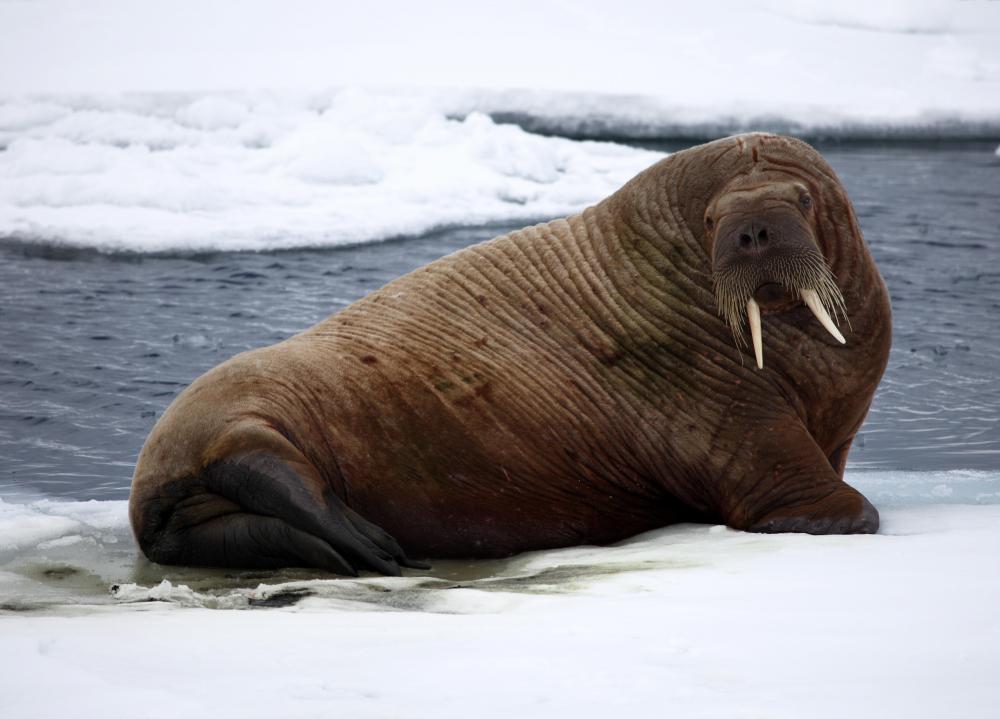At AllThingsNature, we're committed to delivering accurate, trustworthy information. Our expert-authored content is rigorously fact-checked and sourced from credible authorities. Discover how we uphold the highest standards in providing you with reliable knowledge.
Is the Ivory Trade Harmful to Elephants?
Ivory is a unique substance found in several animals including walruses, whales, rhinos, hippopotami, and, most famously, elephants. The close grained creamy white to yellow teeth of these animals lend themselves to carving and have been used in art for centuries by skilled craftspeople. However, an animal must be slaughtered to obtain ivory, since the bulk of the material is actually embedded deep within the skull. This has resulted in the decimation of many animal populations, particularly elephants, leading to severe restrictions on the global ivory trade.
The word “ivory” first appeared in the English language in the twelfth century, and is probably derived from several African words meaning elephant. Elephants have been slaughtered for their valuable ivory for centuries, because their massive size leads to a large yield of the precious material. Had elephants been sustainably and sensibly harvested for their ivory, the ivory trade might not have become an issue. Unfortunately, in the 1970s, automatic weapons started to be used to kill elephants at an alarming rate, and at the peak of the ivory trade, 75,000 Asian and African elephants were being killed every year for their ivory: far more than either population could sustain.

Growing concerns about the killing of elephants to feed the ivory trade led to protection under the Convention on International Trade in Endangered Species (CITES) in 1989; both types of elephant are listed under Appendix I, meaning that all trade in their products is prohibited except under special circumstances. Countries which have agreed to abide by CITES are supposed to heavily prosecute anyone caught trading in post-1989 ivory or poaching elephants for their tusks. Sadly, government corruption has led to a thriving underground ivory trade, and ivory is available to those who want it, for a price.

The ivory trade is most heavily fueled by Asian nations, with the bulk of ivory being processed through nations like China, Japan, India, and Thailand. While the ivory trade has shrunk since elephants were protected under CITES, elephant populations are still under threat of poaching, which is combining with habitat reduction to threaten elephants with extinction in the wild. Poaching for ivory is extremely harmful; not only does it reduce the elephant population, but it also disrupts the social structure of elephant herds, and it costs global governments millions of dollars in anti-poaching efforts and prosecution for illegal trade in ivory.
According to CITES, pre-1989 ivory is legal for trade, along with ivory from some other animal species. In addition, agreements have been reached with certain African nations including Namibia, Botswana, South Africa, and Zimbabwe to allow these nations to sell off their stockpiles of confiscated ivory, along with the tusks of animals culled from recovering elephant populations. Most activists agree, however, that purchasing any type of ivory, even ivory than can be proven legal, supports the ivory trade. Concerned consumers should avoid handling and purchasing ivory for the sake of the elephants, along with other animals slaughtered for their remarkable teeth.
Frequently Asked Questions
Why is the ivory trade considered harmful to elephants?
The ivory trade is devastating for elephants as it directly fuels poaching. According to the World Wildlife Fund, tens of thousands of elephants are killed each year for their tusks. This not only reduces elephant populations but also disrupts their complex social structures, leading to long-term ecological and social consequences for these intelligent creatures.
How does the ivory trade impact elephant populations globally?
Elephant populations have plummeted due to the ivory trade. The African Elephant Database reports that the African elephant population has seen a 62% decline over the last decade in certain regions, primarily due to poaching for ivory. This unsustainable loss threatens the survival of both the African and Asian elephant species.
What are the consequences of the ivory trade on biodiversity and ecosystems?
Elephants are keystone species, meaning their presence is crucial for maintaining biodiversity and ecosystem balance. Their activities, like tree felling and seed dispersal, shape habitats for other species. The ivory trade's reduction of elephant numbers can lead to overgrown vegetation and diminished habitats for other wildlife, disrupting entire ecosystems.
Are there any international laws or agreements that protect elephants from the ivory trade?
Yes, the Convention on International Trade in Endangered Species of Wild Fauna and Flora (CITES) regulates the international trade of elephant ivory. However, enforcement varies by country, and illegal trade persists. Many nations have also enacted domestic bans on ivory sales to bolster protection efforts.
How does the demand for ivory contribute to the trade and poaching of elephants?
Demand for ivory products drives the illegal trade and incentivizes poachers to kill elephants. Despite international regulations, there is still a market for ivory, particularly in Asia, where it's often carved into ornaments and jewelry. As long as there is demand, poachers will continue to target elephants, fueling this illicit industry.
What can individuals do to help combat the ivory trade and its effects on elephants?
Individuals can help by not purchasing ivory or ivory products, spreading awareness about the plight of elephants, and supporting conservation organizations. Additionally, advocating for stronger enforcement of existing laws and international treaties can make a significant impact. Financial contributions to wildlife sanctuaries and anti-poaching initiatives also aid in the protection of elephants.
AS FEATURED ON:
AS FEATURED ON:












Discussion Comments
Do an image search for "ivory trade", the search results alone will show you that the practice is harmful to elephants!
Elephants are intelligent, emotional and family oriented animals. Killing just one for it's TEETH, leaves the whole herd devastated with the loss. They really do grieve over their dead!
If you must have something like this for your home decor, look for vegetable ivory, it carves like ivory and has the same coloring!
Post your comments